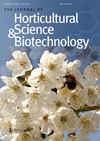Genome-wide identification and characterisation of Aquaporin s in Rosa chinensis
IF 2.1
4区 农林科学
Q2 HORTICULTURE
Journal of Horticultural Science & Biotechnology
Pub Date : 2023-10-26
DOI:10.1080/14620316.2023.2272153
引用次数: 0
Abstract
ABSTRACTAquaporins (AQPs) are small integral membrane proteins that facilitate the efficient transport of small solutes like water, metalloids, urea, and CO2 across the membrane. Plant aquaporins are known to be involved in vital physiological processes like seed germination, stomatal movement, cell elongation, and reproductive growth. In the present study, 36 AQPs were identified through genome-wide computational analysis performed in the rose genome. Subsequent phylogenetic analysis classified the AQPs into five subfamilies, including 10 Plasma membrane intrinsic proteins (PIPs), 8 Tonoplast intrinsic proteins (TIPs), 9 Nodulin intrinsic proteins (NIPs), 3 Small intrinsic proteins (SIPs), and 6 uncharacterised intrinsic proteins (XIPs). Based on the prediction of silicon solute specificity, one of the NIPs is predicted to be a silicon transporter. Structural analysis revealed the characteristic six trans-membrane domains and two-half alpha helix harbouring two conserved NPA motifs in the majority of the predicted AQPs. The protein tertiary structures predicted with homology-based modelling were used to study the pore lining remains and to predict the solute transport activity of the AQPs. Expression profiling of the rose AQPs showed tissue-specific expression of many members. The data provided here will help in understanding the AQP-based solute transport system in roses and other related species.KEYWORDS: AquaporinsRosaceaerosesolute specificitysilicon AcknowledgementsThe authors are thankful to the “Department of Biotechnology (DBT), Government of India (GoI)”, for the “Ramalingaswami Fellowship Award” to R.D. and H.S. and grants BT/PR32853/AGIII/103/1159/2019 and BT/PR38279/GET/119/351/2020 to H.S.; The Science and Engineering Research Board (SERB), India, Department of Science and Technology (DST), Government of India (GoI), for research grant CRG/2019/006599 awarded to R.D., and H.S., and for research grant SRG/2021/000077 to SN. PR thanks the SERB, Govt. of India for the Project Associate-I fellowship. PK thanks the Director, ICAR-Directorate of Floricultural Research for funding support.Disclosure statementNo potential conflict of interest was reported by the authors.Supplementary materialSupplemental data for this article can be accessed online at https://doi.org/10.1080/14620316.2023.2272153Data availability statementThe authors confirm that the data supporting the findings of this study are available within the article and its supplementary materials.Additional informationFundingThe work was supported by the Department of Biotechnology, Ministry of Science and Technology, India [BT/PR32853/AGIII/103/1159/2019]; Science and Engineering Research Board [SRG/2021/000077].中国月季水通道蛋白5的全基因组鉴定与特征分析
四孔蛋白(AQPs)是一种小的完整膜蛋白,促进小溶质如水、类金属、尿素和二氧化碳在膜上的有效运输。植物水通道蛋白参与了重要的生理过程,如种子萌发、气孔运动、细胞伸长和生殖生长。在本研究中,通过对玫瑰基因组进行全基因组计算分析,鉴定出36个AQPs。随后的系统发育分析将AQPs分为5个亚家族,包括10个质膜内在蛋白(PIPs), 8个Tonoplast内在蛋白(TIPs), 9个结节蛋白(NIPs), 3个小内在蛋白(SIPs)和6个未表征的内在蛋白(XIPs)。基于对硅溶质特异性的预测,预测其中一个NIPs是硅转运体。结构分析显示,在大多数预测的aqp中,具有六个跨膜结构域和两个半α螺旋,其中包含两个保守的NPA基序。基于同源性模型预测的蛋白质三级结构被用于研究孔隙衬里残留物,并预测AQPs的溶质运输活性。玫瑰AQPs的表达谱显示了许多成员的组织特异性表达。本文提供的数据将有助于了解玫瑰和其他相关物种中基于aqp的溶质运输系统。作者感谢印度政府(GoI)生物技术部(DBT)授予rd和H.S.“Ramalingaswami奖学金”,并向H.S.授予BT/PR32853/AGIII/103/1159/2019和BT/PR38279/GET/119/351/2020;印度科学与工程研究委员会(塞尔维亚)、印度政府科学技术部(DST)授予研发部和hs的研究资助CRG/2019/006599,以及授予SN的研究资助SRG/2021/000077。PR感谢印度塞尔维亚政府提供项目协会一级奖学金。PK感谢icar花卉研究局主任提供的资金支持。披露声明作者未报告潜在的利益冲突。补充资料本文的补充资料可在https://doi.org/10.1080/14620316.2023.2272153Data网站上获得可用性声明作者确认,支持本研究结果的数据可在文章及其补充资料中获得。本研究得到了印度科技部生物技术司的支持[BT/PR32853/AGIII/103/1159/2019];科学与工程研究委员会[SRG/2021/000077]。
本文章由计算机程序翻译,如有差异,请以英文原文为准。
求助全文
约1分钟内获得全文
求助全文
来源期刊
CiteScore
3.90
自引率
5.30%
发文量
67
审稿时长
3 months
期刊介绍:
The Journal of Horticultural Science and Biotechnology is an international, peer-reviewed journal, which publishes original research contributions into the production, improvement and utilisation of horticultural crops. It aims to provide scientific knowledge of interest to those engaged in scientific research and the practice of horticulture. The scope of the journal includes studies on fruit and other perennial crops, vegetables and ornamentals grown in temperate or tropical regions and their use in commercial, amenity or urban horticulture. Papers, including reviews, that give new insights into plant and crop growth, yield, quality and response to the environment, are welcome, including those arising from technological innovation and developments in crop genome sequencing and other biotechnological advances.

 求助内容:
求助内容: 应助结果提醒方式:
应助结果提醒方式:


